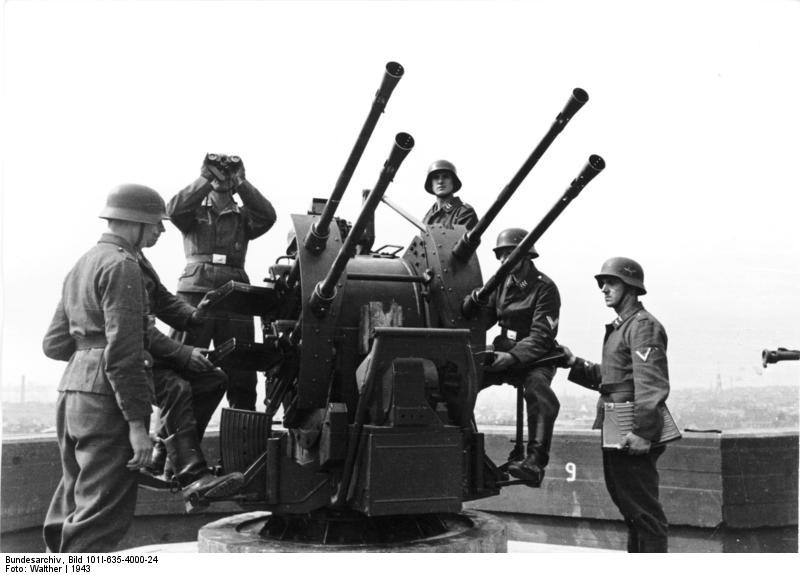At this point in the war, the Allies were sending bombers directly into the heart of Germany but they were taking heavy losses. This is due to the fact that the Nazis had small and quick fighters that could easily shoot down the heavy bombers. Additionally, the Allies didn't possess an aircraft that could go all the way to Germany because they didn't have the fuel capacity. As a result, in an attempt to solve this problem a United States company by the name of Packard and British company named Rolls Royce came together and built the P-51 Mustang. This fighter had more range, better weapons, and highly maneuverable in comparison to the Spitfire which was Britain's main fighter jet. It had a top speed of around four hundred ninety miles per hour and, in later models, had radar capabilities so that it could detect incoming enemy aircraft. Its armaments consisted of around ten rockets, six .50 caliber machine guns, and space for extra fuel tanks or supplies.

The P-51 Mustang could make it all the way to Germany and as a result, the Allies were able to bomb critical Nazi targets because these new fighters could defend against the German air force. Altogether, these aircraft were invaluable and were one of the most popular fighter aircraft at the time. In fact, the infamous Tuskegee airmen used these planes on their raids.
https://www.boeing.com/history/products/p-51-mustang.page
https://nationalinterest.org/blog/buzz/why-nothing-could-stop-p-51-mustang-30287?page=0%2C1

I found your blog post really interesting to read! After looking through some articles, I found that there were actually four versions of the P-51 Mustang that were produced during WWII. In March of 1942, the first P-51A’s were manufactured. However, the Allison engines these planes had severely hindered the planes’ abilities to fly at high altitudes, so most P-51A’s were sent to China, Burma, and India for low altitude combat. Then, in the fall of 1942, Mustangs were fitted with British Merlin engines and those planes were called the P-51Bs and P-51Cs (minimal differences; P-51B was manufactured in California and P-51C in Texas). Since the P-51B and C could fly much faster than the P-51A as a result of a better engine, it provided America and Britain the long-range and high-altitude escort needed for their bombing campaigns against Germany. Finally, there was the P-51D, an even faster aircraft that served as a fighter-bomber and reconnaissance aircraft. Some improvements included a “bubble top” canopy that improved the pilot’s vision, K-14 gunsight, and a simplified ammunition feed that significantly diminished gun jams. As you said, these aircraft were truly invaluable, as by the end of the war, Mustangs alone had destroyed 4,950 enemy aircraft in the air.
ReplyDeletehttps://www.nationalmuseum.af.mil/Visit/Museum-Exhibits/Fact-Sheets/Display/Article/196263/north-american-p-51d-mustang/
This was very helpful to me when I am trying to figure out what may have altered the powers in the war, even if it is slight. As someone who didn't know much about the war until recently, this was great for me to read. Also, I enjoyed the first comment that went even deeper on the subject. I am surprised to see the amount of times the plane was upgraded and changed in such a short period of time. Is that normally the case during wartime to make so many upgrades on machinery?
ReplyDeleteI found your article really interesting! I remember the P-51 mentioned somewhere when I was researching the B-17. While both of these planes are American made, I decided to look into planes from other countries during WWII, specifically Japan. Japan produced the Mitsubishi Zero plane (A6M), a fighter monoplane designed to fly off aircraft carriers. It had an external drop tank, allowing it to fly at great distances, and had great maneuvering capabilities. It was a superb plane in dogfights, and due to it's light weight could keep up with heavier American planes in dives, the light weight coming from carrying less ammunition and a less powerful engine. The A6M was used as kamikazi plane in the closing months of the war.
ReplyDeletehttps://www.britannica.com/technology/Zero-Japanese-aircraft
I really enjoyed reading this article and it showed me the importance of the P-51 Mustang. Although I already sort of knew this plane, I wanted to do some more research on it and how the development of this plane affected later models of aircraft. The P-51 Mustang was adopted and re-titled the F-51 at the beginning of the Korean war and was used by the United Nations until jet fighters were utilized. The P-51 was such a revolutionary plane that it served alongside more advance jet aircraft as bombers up to the early 1980's where it then became a civilian race plane or collector's war bird.
ReplyDeleteSource: https://en.wikipedia.org/wiki/North_American_P-51_Mustang
I enjoyed reading your article, especially how you mentioned it was superior to the Supermarine Spitfire, a British single-seat fighter aircraft. I learned that the P-51 was first introduced in January of 1942, with more than 15,000 units being made during its production run. In 1984, the aircraft was finally withdrawn from military service, being retired by the Dominican Air Force. In 1945, a single P-51 cost around $50,985, which amounts to $570,000 in 2018 money. The original P-51 also laid out the foundation as a basis for more planes in the future, including the F-82 Twin Mustang and the Piper PA-48 Enforcer.
ReplyDeletehttps://www.britannica.com/technology/P-51
https://www.nationalmuseum.af.mil/Visit/Museum-Exhibits/Fact-Sheets/Display/Article/195782/piper-pa48-enforcer/
https://www.boeing.com/history/products/p-82-twin-mustang.page